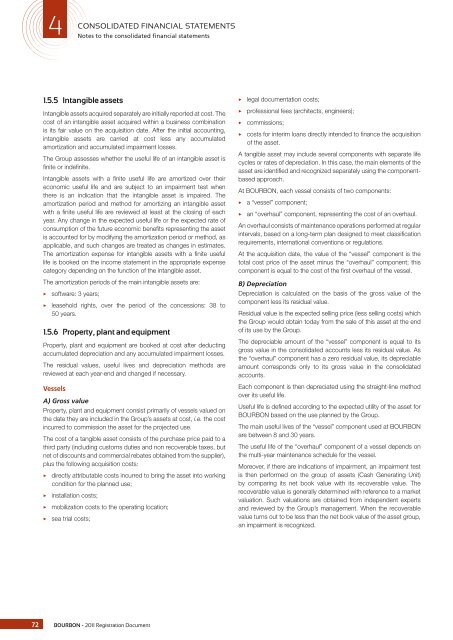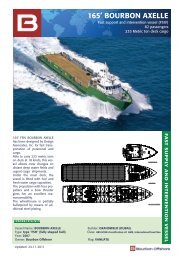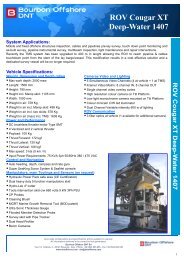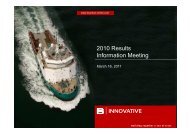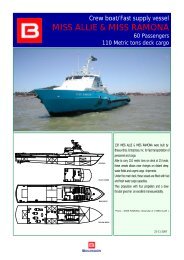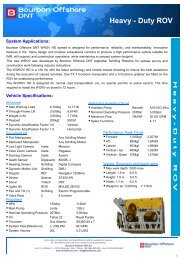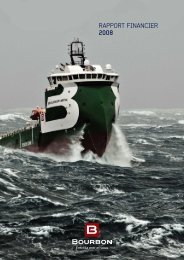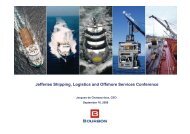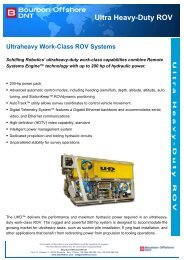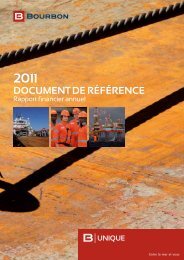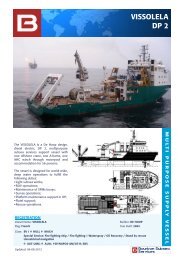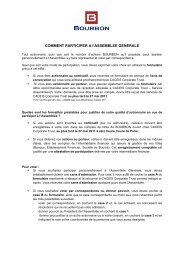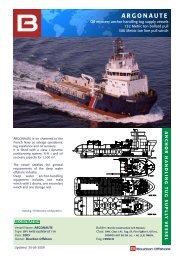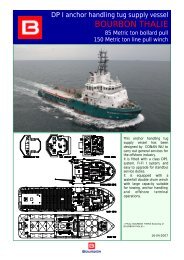4NotesCONSOLIDATED FINANCIAL STATEMENTSto the consolidated financial statements1.5.5 Intangible assetsIntangible assets acquired separately are initially reported at cost. Thecost of an intangible asset acquired within a business combinationis its fair value on the acquisition date. After the initial accounting,intangible assets are carried at cost less any accumulatedamortization and accumulated impairment losses.The Group assesses whether the useful life of an intangible asset isfi nite or indefi nite.Intangible assets with a fi nite useful life are amortized over theireconomic useful life and are subject to an impairment test whenthere is an indication that the intangible asset is impaired. Theamortization period and method for amortizing an intangible assetwith a fi nite useful life are reviewed at least at the closing of eachyear. Any change in the expected useful life or the expected rate ofconsumption of the future economic benefi ts representing the assetis accounted for by modifying the amortization period or method, asapplicable, and such changes are treated as changes in estimates.The amortization expense for intangible assets with a fi nite usefullife is booked on the income statement in the appropriate expensecategory depending on the function of the intangible asset.The amortization periods of the main intangible assets are:3 software: 3 years;3 leasehold rights, over the period of the concessions: 38 to50 years.1.5.6 Property, plant and equipmentProperty, plant and equipment are booked at cost after deductingaccumulated depreciation and any accumulated impairment losses.The residual values, useful lives and depreciation methods arereviewed at each year-end and changed if necessary.VesselsA) Gross valueProperty, plant and equipment consist primarily of vessels valued onthe date they are included in the Group’s assets at cost, i.e. the costincurred to commission the asset for the projected use.The cost of a tangible asset consists of the purchase price paid to athird party (including customs duties and non recoverable taxes, butnet of discounts and commercial rebates obtained from the supplier),plus the following acquisition costs:3 directly attributable costs incurred to bring the asset into workingcondition for the planned use;3 installation costs;3 mobilization costs to the operating location;3 sea trial costs;3 legal documentation costs;3 professional fees (architects, engineers);3 commissions;3 costs for interim loans directly intended to fi nance the acquisitionof the asset.A tangible asset may include several components with separate lifecycles or rates of depreciation. In this case, the main elements of theasset are identifi ed and recognized separately using the componentbasedapproach.At BOURBON, each vessel consists of two components:3 a “vessel” component;3 an “overhaul” component, representing the cost of an overhaul.An overhaul consists of maintenance operations performed at regularintervals, based on a long-term plan designed to meet classifi cationrequirements, international conventions or regulations.At the acquisition date, the value of the “vessel” component is thetotal cost price of the asset minus the “overhaul” component; thiscomponent is equal to the cost of the fi rst overhaul of the vessel.B) DepreciationDepreciation is calculated on the basis of the gross value of thecomponent less its residual value.Residual value is the expected selling price (less selling costs) whichthe Group would obtain today from the sale of this asset at the endof its use by the Group.The depreciable amount of the “vessel” component is equal to itsgross value in the consolidated accounts less its residual value. Asthe “overhaul” component has a zero residual value, its depreciableamount corresponds only to its gross value in the consolidatedaccounts.Each component is then depreciated using the straight-line methodover its useful life.Useful life is defi ned according to the expected utility of the asset forBOURBON based on the use planned by the Group.The main useful lives of the “vessel” component used at BOURBONare between 8 and 30 years.The useful life of the “overhaul” component of a vessel depends onthe multi-year maintenance schedule for the vessel.Moreover, if there are indications of impairment, an impairment testis then performed on the group of assets (Cash Generating Unit)by comparing its net book value with its recoverable value. Therecoverable value is generally determined with reference to a marketvaluation. Such valuations are obtained from independent expertsand reviewed by the Group’s management. When the recoverablevalue turns out to be less than the net book value of the asset group,an impairment is recognized.72BOURBON - 2011 Registration Document
CONSOLIDATED FINANCIAL STATEMENTS4Notes to the consolidated financial statementsOther property, plant and equipment (excluding vessels)Property, plant and equipment, other than the vessels and investmentproperty, are carried at cost as defi ned by IAS 16 § 16. These assetsconsist of a single component.The depreciable amount of other tangible assets is equal to theirpurchase price, their residual value being zero, with the exception ofcertain buildings for which there is a residual value.Other assets are depreciated using the straight-line method overtheir useful life.The main useful lives for property, plant and equipment, excludingvessels, are as follows:3 construction and buildings: between 8 and 40 years;3 technical facilities: between 10 and 15 years;3 other property, plant and equipment: between 2 and 10 years.Investment propertiesThe investment properties held by the Group are recognized in theconsolidated accounts at historical cost and depreciated using thestraight-line method over 40 years.1.5.7 Investments in associatesThe Group’s equity interests in its associates are recognized usingthe equity method. An associate company is an entity over whichthe Group has signifi cant infl uence. Investments in associatesare recognized as assets on the balance sheet for the part ofshareholders’ equity they represent. The goodwill on an associatedcompany is included in the book value of the equity interest.1.5.8 Investments and other financial assetsFinancial assets included in the scope of application of IAS 39 areclassifi ed as “fi nancial assets at fair value through profi t or loss”,as “loans and receivables”, as “held-to-maturity investments”, oras “available-for-sale fi nancial assets”. When initially recognized,fi nancial assets are measured at fair value, plus transaction costs inthe case of investments which are not recognized at fair value throughprofi t or loss. Initially, the Group analyzes the possible existence ofembedded derivatives in the contracts. Embedded derivatives areseparated from the host contract if the contract is not recognized inits entirety at fair value through the income statement, and if analysisshows that the economic features and the risks of the embeddedderivatives are not closely related to those of the host contract.The Group determines the classifi cation of its fi nancial assets at thetime of initial recognition and reviews this classifi cation at each yearlyclosing when this is authorized and appropriate.All “normalized” purchases and sales of fi nancial assets arerecognized on the transaction date, i.e. the date on which the Groupagrees to purchase the asset. “Normalized” purchases or sales arepurchases or sales of fi nancial assets under a contract, the termsof which require the delivery of the asset within the period generallydefi ned by the regulations or by a convention on the market inquestion.Financial assets at fair value through profit or lossThe category of “fi nancial assets at fair value through profi t or loss”includes fi nancial assets held for trading purposes and fi nancialassets designated at the initial accounting as fi nancial assets at fairvalue through profi t or loss. Further details are given in note 3.20.Loans and receivablesLoans and receivables are non-derivative fi nancial assets, withfi xed or determinable payments, which are not listed on an activemarket. After initial recognition, loans and receivables are measuredat amortized cost using the effective interest rate method, less, ifapplicable, an impairment loss. The amortized cost is calculatedby taking into account any initial additional cost or discount, andincludes commissions which are an integral part of the effectiveinterest rate, as well as transaction costs.Gains and losses are recognized as income/loss when the loansand receivables are derecognized or depreciated and through themechanism of amortized cost.Held-to-maturity investmentsHeld-to-maturity investments are non-derivative fi nancial assets,with fi xed and determinable payments and a fi xed maturity, whichthe Group has the positive intent and the ability to hold to maturity.After initial recognition, held-to-maturity investments are measuredat amortized cost.Available-for-sale financial assetsAvailable-for-sale fi nancial assets are non-derivative fi nancial assetswhich are designated as being available for sale and which are notclassifi ed in any of the following three categories: “fi nancial assets atfair value through profi t or loss”, “held-to-maturity investments”, or“loans and receivables”.After initial recognition, available-for-sale fi nancial assets aremeasured at fair value, and the gains and losses on such assetsare booked directly as shareholders’ equity in a separate line(“Unrealized net gains”) until the investment is derecognized or untilthe investment is identifi ed as being subject to impairment, in whichcase the cumulative gain or loss previously booked as shareholders’equity is then included in profi t or loss.Determining the fair value of financial instrumentsThe fair value of the fi nancial instruments that are actively traded onorganized fi nancial markets is determined by reference to the marketprices published on the closing date. For investments for whichthere is no active market, fair value is determined using valuationtechniques. Such valuation techniques include: using recent arm’slength market transactions between knowledgeable and willingparties, reference to the current fair value of another instrument thatis substantially the same, discounted cash fl ow analysis and optionpricing models. If applicable, fair value is assessed on the basis ofBOURBON - 2011 Registration Document 73


